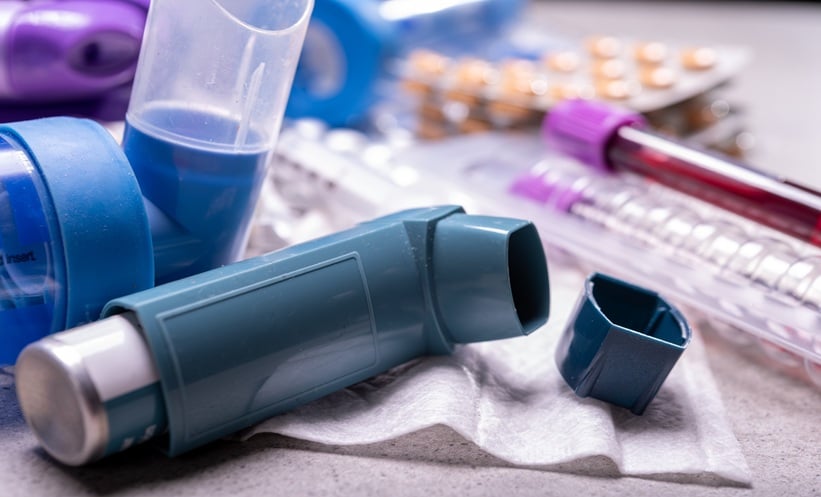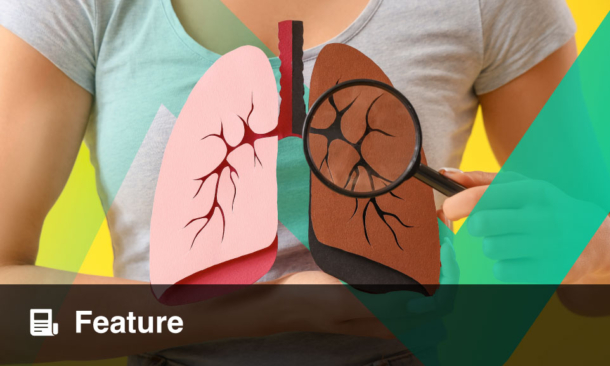Interview Summary
COPD is a leading cause of morbidity and mortality worldwide. Inhaled therapies are the mainstay of COPD treatment, including pressurised metered dose inhalers (pMDI), pMDIs with a spacer, soft mist inhalers (SMI), dry powder inhalers (DPI), and nebulisers. Inhalation devices each have distinct advantages and challenges, and selecting the most appropriate device for a patient with COPD is crucial to maximising the benefit of inhaled therapy. In this expert interview, pulmonologist Donald Mahler, Geisel School of Medicine at Dartmouth, Hanover; and Valley Regional Hospital, Claremont, New Hampshire, USA, offers insights into the nuances of inhaler selection, emphasising how clinical- and patient-specific factors should guide decision-making. He clarifies the roles of different delivery systems, including the role of nebulisers in certain clinical scenarios, and describes how nebuliser efficiency can be objectively measured in terms of the ability to deliver therapeutic doses of medication into the lungs. A case study illustrates the benefits of switching to nebuliser therapy when a patient’s symptoms do not improve with an appropriately used handheld device. Mahler also addresses the impact of mucus overproduction in patients with COPD, highlights therapeutic strategies including nebulised agents and positive expiratory pressure (PEP) therapy, and introduces a new interactive COPD Inhalation Device Selection Tool (PARI GmbH, Starnberg, Germany) designed to help healthcare providers (HCP) to make tailored, evidence-informed choices for their patients.INTRODUCTION
Inhalation therapy is central to the treatment of patients with COPD,1 a condition that affects an estimated 480 million people; roughly 10% of the global population.2 Inhaled therapies deliver medication directly to the lungs, with the benefit of rapid onset of effect and reduced systemic exposure compared with oral or intravenous administration.3
It is critical to ensure that any inhaled drug reaches the site of action in sufficient quantity to exert the desired therapeutic effect.1 To optimise the benefit–risk ratio of inhaled therapy, the most suitable device should be selected.4
To discuss these issues, the European Medical Journal (EMJ) sat down with Mahler, a pulmonologist with extensive experience and expertise in COPD, based at Valley Regional Hospital in Claremont, New Hampshire, USA.
INHALATION DEVICES AND FACTORS AFFECTING SELECTION
Mahler outlined the differences between currently marketed inhalation devices, highlighting patient challenges and how they should inform device selection.
Numerous Publications Have Shown That Not All Inhalation Devices Are Suitable for the Treatment of All COPD Patients. This Can Result in Poor Patient Outcomes. Can You Share Your Perspective on This Issue?
Inhaled therapy in COPD is delivered via four principal device types: pressurised metered dose inhalers (pMDI), dry powder inhalers (DPI), soft mist inhalers (SMI), and nebulisers.5 While drug availability is an important consideration, effective treatment hinges on aligning the device with individual patient factors.5
For HCPs, selecting the optimal device can be complex;5 with each system presenting unique handling requirements, physiological demands, and logistical considerations. Key distinguishing features are outlined in Table 1.

Table 1: Key factors of different types of inhalation device.
DPI: dry powder inhaler; pMDI: pressurised metered-dose inhaler; SMI: slow-mist inhaler.
Studies show that up to 87% of patients with COPD make at least one inhaler technique error with pMDIs.7 It is believed that these errors restrict delivery of the inhaled medication into the lower respiratory tract,5,8 resulting in an increased risk of COPD exacerbations, worse health status, overuse of inhaled corticosteroids, and frequent hospitalisation.3,5 In addition, at least half of patients with acutely exacerbated COPD do not reach optimal peak inspiratory flow (PIF) for DPI usage,9,10 which itself may result in worse COPD-related symptom burden, and a greater likelihood of COPD-related hospital readmissions.9,11
What Key Patient-specific Factors Influence the Choice of an Optimal Inhalation Device? How Can Healthcare Providers Assess and Prioritise These Factors to Ensure Effective Therapy?
HCPs should consider three key questions when selecting an inhalation device to prescribe:
- Does the patient have sufficient cognitive function to follow instructions and use handheld devices?
- Does the patient have sufficient manual dexterity to use the handheld device correctly?
- Does the patient have sufficient PIF to de-aggregate the powder in a DPI?
The answers to these questions can narrow down the most appropriate inhalation devices for the patient.5,12 For example, nebulisers may be the most suitable devices for patients with impaired cognitive function or poor manual dexterity, and DPIs are unlikely to be suitable for patients with suboptimal PIF.5,12
It is important to teach patients with COPD to use their prescribed inhalation device correctly, and this can include the use of the “teach-back” approach, handouts, and training videos.4
If a patient reports little symptom improvement with the use of their current inhaler, they should be asked to demonstrate their inhaler technique. If they are using their inhaler correctly but not getting any benefit, their HCP should consider switching to a different inhalation device.5
THE SPECIFIC CASE OF NEBULISERS
Nebulisers are typically prescribed when patients are unable to use handheld devices correctly, due to impaired cognitive function, poor manual dexterity, or suboptimal PIF, or when a handheld device is not providing the patient with adequate symptom relief.5 Patient preference is also a consideration,13 and Mahler explained that some of his patients choose to use a nebuliser to administer on-demand short-acting bronchodilators, while others use a nebuliser for maintenance medication.
How Do Different Nebuliser Types Compare in Terms of Clinical Efficacy and Efficiency for COPD Treatment, and to What Extent Should These Factors Influence Device Selection in Clinical Practice?
Nebulisers can be divided into three main types: jet, ultrasonic, and vibrating mesh, depending on the mechanism by which they generate an aerosol.3 Jet nebuliser systems can be continuous, or more efficient types include breath-actuated (delivery during inhalation only), or breath-enhanced (delivery increased during inspiration and reduced on expiration).14
The selection of a specific nebuliser should be based on the efficiency of the device, in order to optimise medication delivery.15-17 Nebuliser efficiency depends on the respirable dose of medication that reaches the lungs per minute.17 The respirable dose is dependent on both the aerosol output of the nebuliser and the respirable fraction of the aerosol (the proportion of particles <5 µm).17 Therefore, the respirable drug delivery rate (RDDR) can serve as an objective measure to compare the efficiency of different nebulisers in delivering medication to the lower respiratory tract.17,18
There have been a significant number of in vitro studies that demonstrate breath-enhanced and breath-actuated nebulisers deliver medication more efficiently than continuous nebulisers.19-23 Comparative data on RDDR is available to help HCPs select the most effective device for their patients.
What Limitations Can Healthcare Providers Face When Selecting the Correct Nebuliser?
In many countries, long-acting beta agonists (LABA), long-acting muscarinic antagonists (LAMA), and inhaled corticosteroids are all available.3,5 The phosphodiesterase (PDE) 3/4 inhibitor, ensifentrine, was only available in the USA as of the time of writing.24 In some countries/regions, there is limited or no access to these COPD medications, which restricts the use of nebulisers to on-demand, rather than maintenance therapy.6,25,26
Could You Share a Case Study from your Clinical Practice Where Nebuliser Therapy Significantly Improved Outcomes for a Patient with COPD?
A 67-year-old patient with moderate COPD (FEV1 58% predicted) was referred for pulmonology consultation following two emergency department visits within three days for acute dyspnoea. Treatment during these visits included short-acting muscarinic antagonist (SAMA) delivered via nebulisation, azithromycin, and a short course of oral prednisone (40 mg/day).
At the time of assessment, the patient reported persistent shortness of breath during minimal exertion (e.g., walking between rooms). Routine testing revealed normal alpha-1-antitrypsin levels and a clear chest X-ray. Maintenance therapy consisted of a LABA/LAMA combination via SMI, and the patient reported frequent reliance (6–8 times daily) on a SABA pMDI, with limited symptom relief.
Based on clinical history and persistent symptom burden, the patient was prescribed a combination SAMA/SABA therapy via jet nebuliser for on-demand use, while continuing their existing maintenance regimen.
At a follow-up visit 3 weeks later, the patient reported marked improvement in symptom control and overall satisfaction with the new inhalation strategy. This case highlights how transitioning select patients to nebulised therapy may enhance bronchodilation and reduce emergency care utilisation.
IMPACT AND OPTIONS FOR EXCESSIVE LUNG SECRETION
How Does Excessive Mucus Production in Patients with COPD Impact Their Respiratory Function, Quality of Life, and Clinical Outcomes?
A subtype of COPD, chronic bronchitis, is characterised by a productive cough caused by excessive mucus production,15 airway obstruction, and inflammation.27 These patients often report feeling that they cannot cough up the mucus in their lungs.
Excessive mucus production is increasingly recognised as an important factor in COPD, though its precise role in the pathogenesis of the disease is not fully understood.28-31 Recent studies have indicated that the presence of mucus plugs on CT scan is associated with increased mortality, higher exacerbation rates, and lung function decline,32-35 demonstrating the importance of their management for optimal patient outcomes.
What Are the Treatment Options for Patients with COPD Who Experience Excessive Mucus Production?
It is important to recommend smoking cessation as a simple and effective way to reduce mucus production among patients with COPD who smoke.4,36 Patients should also drink plenty of water, as this may help to hydrate and thin the mucus.
Although there is a lack of robust clinical studies to support the recommendation of specific interventions for excessive mucus production in COPD, several therapies have been considered.4 For example, the use of mucolytic drugs has been shown to reduce exacerbations,4,31 and nebulised hypertonic saline is sometimes used to assist mucus clearance in patients with COPD.37-40
Another treatment that may improve mucus mobilisation in COPD is oscillatory positive expiratory pressure (OPEP) therapy.4,41,42 OPEP devices generate oscillating intra-thoracic pressure in the lungs, reducing the viscoelasticity of bronchial secretions and helping to move mucus plugs towards the central and upper airways.41
THE COPD INHALATION DEVICE SELECTION TOOL
Mahler explained that there are some published tools or instruments available to support HCPs with the choice of inhalation device for their patients.4,12,43,44 He outlined the first interactive, open-access tool that has recently been developed to address this need: the COPD Inhalation Device Selection Tool.45
How Can the COPD Inhalation Device Selection Tool Enhance Clinical Decision-making in Choosing Optimal Inhalation Devices, and in Which Specific Healthcare Settings or Scenarios Might It Be Most Beneficial?
The objective of the COPD Inhalation Device Selection Tool is to support HCPs in the personalised selection of an inhalation device to improve individual patient outcomes. The tool narrows down the suitable options for a patient, simplifying the HCP’s choices (Figure 1). Upon opening the online interactive tool, the first screen displays a grid with cognitive function and/or manual dexterity on the x-axis and PIF on the y-axis, allowing HCPs to select the grid segment that best represents their patient’s profile. Clicking on the appropriate segment reveals the most suitable delivery system option(s) for that patient. Additional information is supplied in pop-up boxes to provide further guidance, such as the advantages and disadvantages of each device, and why one device might be more appropriate for their patient than another.45

Figure 1: Screenshots from the COPD Inhalation Device Selection Tool.24
The creation of this tool was funded by PARI GmbH and developed in collaboration with EMJ.
Upper image shows the initial screen of the interactive tool, permitting selection of a patient’s cognitive function and/or manual dexterity from normal to impaired on the x-axis, and their peak inspiratory flow, from optimal to suboptimal, on the y-axis. Lower images show examples of recommendations that are provided on clicking specific areas of the screen (A–B). Further information available to the user is shown in three text boxes (1–3).
DPI: dry powder inhaler; ICS: inhaled corticosteroid; LABA: long-acting beta-antagonist; LAMA: long-acting muscarinic antagonist; O-PEP: oscillating positive expiratory pressure; PDE3/PDE4: phosphodiesterase 3 and 4; PEP: positive expiratory pressure; pMDI: pressurised metered-dose inhaler; SABA: short-acting beta-antagonist; SAMA: short-acting muscarinic antagonist; SMI: soft mist inhaler; VHC: valved holding chamber.
A key advantage of the interactive selection tool is that it can be accessed on a laptop, an electronic tablet, or even a mobile phone. It could be used by a medical assistant to screen a patient and report the recommended devices to the HCP, potentially saving them some face-to-face appointment time. The COPD Inhalation Device Selection Tool is available to all healthcare settings, yet it may be of particular value to primary care, supporting HCPs by simplifying the selection of the most appropriate device(s) for each of their patients.
CONCLUSION
Selecting the appropriate inhalation device is complex and highly dependent on patient-specific factors. The COPD Inhalation Device Selection Tool was developed to support HCPs in navigating this complexity, enabling more personalised, effective treatment, and ultimately improving patient outcomes.







